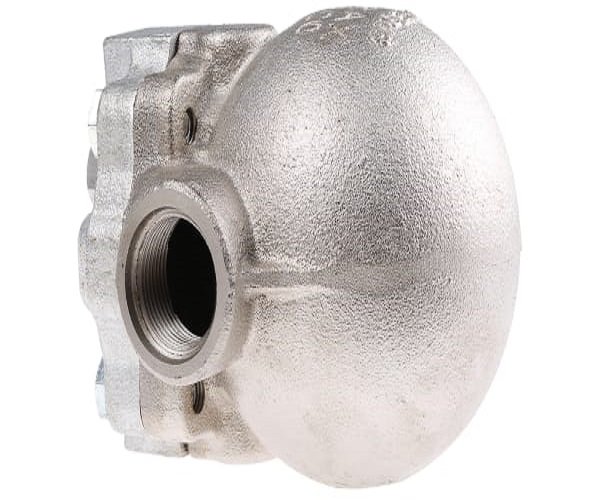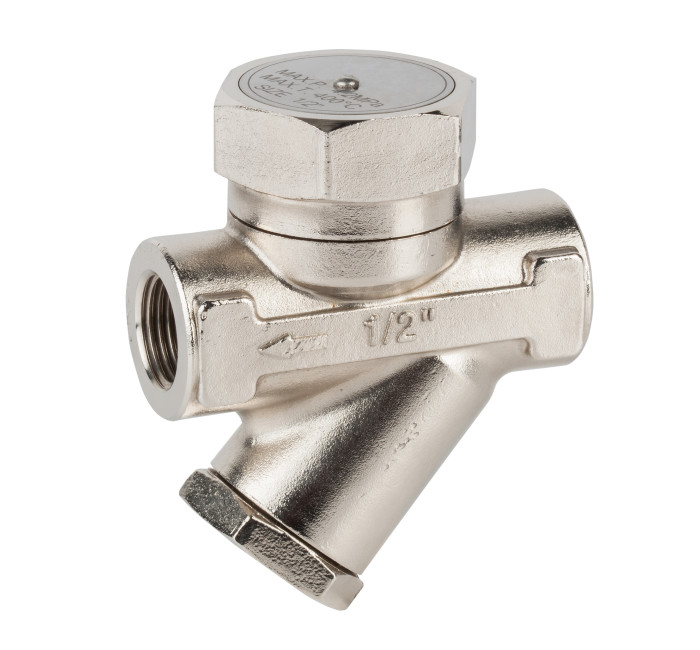
To remove the same amount of condensate at a certain differential pressure, you can use different types of traps. All traps have a specific technical performance and an optimum operating range. The choice is based on the conditions of use. You should not select a trap simply from the point of view of maximum discharge capacity, nor should you choose a trap based solely on the size of the condensate pipe diameter. In general, when selecting a trap, the first step is to choose the most suitable form of the valve according to the conditions of use and installation location concerning the technical performance of the various traps. Then we can select the trap specification and quantity from the manufacturer’s catalog according to the working pressure difference and condensate volume before and after the trap.
①We should not select a hole-trigger trap when the condensate load changes to less than 15% of the rated maximum discharge capacity. It is because, under low loads, it will cause a partial loss of fresh steam leakage.
②In cases where you must remove condensate after it has formed, we should not use orifice traps. Neither should we use a thermostatic bellows-type trap. Both require a certain degree of subcooling (approximately 1.7 to 5.6°C).
③Orifice plate traps and thermostatic traps do not remove condensate immediately. Therefore, we must not use them on steam turbines, steam pumps, or steam mains with manifolds. We do not use them even for the drainage of turbine casings. In all of the above cases, we use float traps. You can also use thermodynamic traps when necessary.
④ Thermodynamic traps have near-continuous drainage performance. Therefore, it has many applications and can generally be used. However, its maximum allowable back pressure must not exceed 50% of the inlet pressure. It also requires that you should use float traps in quiet locations.
⑤ For intermittent indoor steam heating equipment or piping, we can use inverted bucket traps. Again, it is because of its good exhaust performance.
⑥We should not use mechanical traps for traps installed outdoors again. And we should have anti-freeze measures (such as stopping and emptying, insulation, etc.) when necessary.
⑦The location of trap installation varies. However, there are three general categories based on the direction of condensate flow and the movement of the trap.
It is shown in the below location diagram.
(a) Any form of trap can be used as shown.
(b) The floating bucket type shown is not available. However, you may use bimetallic traps.
(c) The formation of condensate shown in (c) is the same as the elevation of the trap location. You may choose a floating bucket, thermodynamic or bimetallic trap

What are the applications for steam traps?
①We can determine the differential pressure between the inlet and outlet of a steam trap based on the actual operating conditions. The inlet pressure of a steam trap is the minimum operating pressure at the inlet of the steam trap due to fluctuations in steam pressure or throttling of the temperature regulator valve. The outlet pressure of a steam trap is the highest working backpressure that may develop after the steam trap. When discharged to the atmosphere, the actual differential pressure is determined by the steam trap inlet pressure. Therefore, you should generally install this type of valve horizontally in the piping.
② Based on the amount of condensate generated by the steam heating equipment during regular operation, multiplied by the selection correction factor k. We can then select the steam trap according to its discharge capacity.
③The amount of condensate can be calculated using the following methods.
(1) The amount of condensate generated when the pipeline is in operation Q=q0L(1-Z/%)(kg/h), in this formula
Q: condensate volume (kg/h)
q0: the amount of condensation generated by the light pipe (kg/h)
L: distance between hydrophobic points (m)
Z: insulation efficiency (%)
(2) The amount of condensation water generated by the operation of steam heating equipment Q=VrC∆T/Ht, in this formula
Q: condensation water (kg/h)
V: the volume of the object to be heated (m3)
r: density of the object to be heated (kg/ m3)
C: specific heat of the liquid (kcal/kg.OC)
△ T: temperature rise of the liquid (OC)
H: latent heat of vapor (kcal/kg)
t: Heating time
④ Various types of steam traps differ in structure and principle. The performance of traps also varies. We can choose different steam traps for different applications.
1) Principle
Changes in condensate level drive the principle of mechanical steam traps.
Changes in condensate temperature drive thermostatic steam traps.
The dynamic characteristics of the condensate drive thermodynamic steam traps.
2) Main Control Parameters
The main technical parameters of steam traps include nominal size, nominal pressure, differential operating pressure, operating temperature, back pressure, condensate discharge, etc.
3) Functions
Rapidly removes condensate generated.
Prevent steam leakage.
Prevent water strikes
Prevent reduction in the efficiency of steam-using equipment
Prevent corrosion of the interior of steam-using equipment
4) Selection
(1) In the condensate recovery system, if the working back pressure is used to recover condensate, you should choose a steam trap with a high backpressure rate (such as mechanical steam traps).
When no condensate is required to accumulate in steam-using equipment, you should use steam traps that continuously discharge saturated condensate (e.g., float type steam traps).
(2)In condensate recovery systems, steam-using equipment requires the discharge of saturated condensate and the timely removal of non-condensable gases. In this case, you should use a steam trap that can discharge soaking water in parallel with an exhaust device or a steam trap that has both drainage and exhaust functions (e.g., thermostatic steam trap).
When the working pressure of steam-using equipment fluctuates frequently, you should choose steam traps that do not require adjustment of working pressure.
(3) The steam trap’s nominal pressure and operating temperature should be greater than or equal to the maximum working pressure and maximum working temperature of the steam piping and steam-using equipment.
(4) When the drainage capacity of a steam trap does not meet the requirements, you may install several steam traps in parallel.
(5) To facilitate maintenance, you may install a bypass pipe and bypass valve.
5) Construction and installation points
(1) Before installation, we should clean the piping equipment and remove impurities to avoid blockage.
(2) Steam traps must be installed below the lowest point of steam-using equipment and in places where they can be quickly drained and serviced. We also need to arrange them as centrally as possible for ease of management. In connecting them, they should be secure and tight.
(3) When installing them, we should pay attention to the direction of the arrow on the valve body and the rule of media flow in the pipeline.
(4) For steam traps without a strainer, we should install a filter in front of the valve. It shall not be less than 1.5 times the area of the passage over the flow. You should set the filter in a position that can be easily removed and installed.
(5) We should take anti-freeze measures where freezing is likely to occur.
(6) After the steam trap has been installed, we need to conduct a hydrostatic test. The test pressure is the same as the test pressure of the piping system in which it is located.
(7) For installation practice requirements, we need to refer to National Architectural Design Standard Drawing 05R407 《Selection and Installation of Steam Condensate Recovery and Trapping Devices》and manufacturers’ samples.
6) Implementation standards
(1) Product Standards
《Steam Trap Terminology, Marking, Structure Length》 GB/T 12250-2005
《Steam Trap Test Methods》 GB/T 12251-2005
《Steam Heating System Condensate Recovery and Steam Trap Technical Management 《Requirements》GB/T 12712-1991
《 steam traps Product quality classification》JB/T 53169-1994
《Steam Traps Technical Conditions》JB/T 9093-1999
《General Requirements for Steel Valves》GB/T 12224-2005
(2)Engineering standards
《Code of Construction Quality Acceptance for Water Supply and Drainage and Heating Works of Buildings》GB 50242-2002
《Code of Construction Quality Acceptance for Ventilation and Air Conditioning Works 》(GB 50243-20023), related standards Figure 05R407
《 selection and installation of steam condensate recovery and hydrophobic devices》







